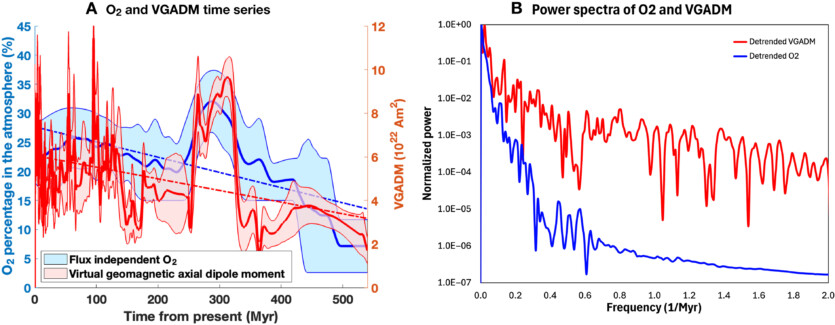
NASA scientists revealed the mechanism 540 million years old, associated with a shift in the Earth’s magnetic field, which affects the level of oxygen in the atmosphere.
A new NASA analysis indicates that over the past 540 million years, the Earth’s magnetic field and oxygen levels have followed very similar patterns. The movement of molten metal in the core of our planet generates a magnetic field. The strength of this magnetic field changes as the flow in the core shifts. It turned out that earth’s magnetic field and the level of oxygen in the atmosphere changed synchronously.
The history of changes in our planet’s magnetic field is stored in magnetized minerals. After hot minerals rise with magma between expanding tectonic plates, they cool and store information about changes in the magnetic field around them. This information will be stored until these minerals are heated to high temperatures again.

Temporal changes in oxygen content and virtual geomagnetic axial dipole moment over the past 540 million years/Science Advances
Scientists can learn about historical oxygen levels from ancient rocks and minerals because their chemical composition depends on the amount of oxygen available during their formation. Data on both the Earth’s magnetic field and oxygen cover comparable ranges in databases compiled by numerous geophysicists and geochemists NASA scientists emphasize, that no one has yet conducted a detailed comparison of these records.
«The two datasets are very similar. Earth — is the only known planet with complex life. The correlations we have found can help us understand how life evolves and how it is connected to the planet’s internal processes», — explains study co-author and geophysicist Goddard Space Flight Center, Weijia Kuang.
Quang and his colleagues analyzed two separate data sets and determined that Earth’s magnetic field. For more than half a billion years, since the Cambrian period, when complex life forms appeared on our planet, the level of oxygen in the atmosphere has followed a rising and falling pattern.
«This correlation raises the possibility that both the magnetic field strength and the level of oxygen in the atmosphere respond to the same basic process, such as the movement of the Earth’s continents», — emphasizes the study’s co-author, is a biogeochemist at the University of Leeds, Benjamin Mills.
The researchers hope to study longer datasets to see if the correlation stretches further back in time. They also plan to examine the historical diversity of other chemicals essential to life as we know it, such as nitrogen, to determine if they support these patterns.
The results of the study are published in the journal Science Advances
Source: SciTechDaily

Spelling error report
The following text will be sent to our editors: